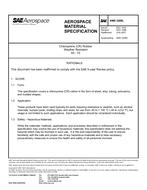Click here to purchase
This SAE Recommended Practice defines the test conditions, procedures, and performance requirements for PTC (positive temperature coefficient of resistance) overcurrent protection devices. PTCs are typically either polymeric (PPTC) or ceramic (CPTC). It is important to note battery voltages versus powernets/system voltage versus max battery voltages: (12 V/14 V/16 V, 24 V/28 V/32 V, and 36 V/42 V/58 V). All voltages are DC. These devices are typically rated with a maximum operating voltage, which for vehicular systems need to be 16 V (for 12 V batteries), 32 V (for 24 V batteries), and 58 V (for 36 V batteries/42 V powernets). PTC devices are considered to be self-resetting after responding to overcurrent conditions and after such condition has been removed from the affected circuit containing the PTC.The test and evaluation requirements of this document are sufficient to determine relative performance regardless of maximum voltage rating. The suitability of any given PTC device for 42 V electrical systems is dependent upon the manufacturer’s design and performance characteristics in higher voltage applications. Whereas electrical arc generation in live circuits poses a hazard to equipment and operators, it is also the recommendation of the Circuit Protection Task Force that vehicular electrical applications employ adequate safety measures to prevent live engage or disengage occurrences of these electrical devices.
Product Details
- Published:
- 05/18/2006
- File Size:
- 1 file , 840 KB


